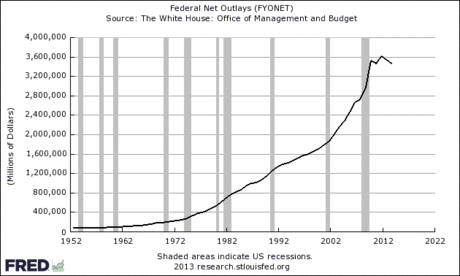Is spending out of control in Washington? The answer depends on how you define your terms. There’s enough data to spin this any way you want. But let’s try to be objective. In truth, there’s no single, fully objective way to quantify the spending habits of the beast in Washington. We can, however, make a valiant effort by considering federal outlays from several perspectives. What we’ll find is a spending trend of late that’s in decline. It’s anyone’s guess if this will endure. As always, the answer relies on political decisions, which are constrained at the moment due to the automatic budget cuts that are currently the law of the land. For now, let’s consider what the current numbers tell us about the trend in budgetary matters.
Federal net outlays, measured on a year-over-year basis, are in retreat at the moment. As Michael Darda at MKM Partners observed last week in a research note , we’ve recently witnessed the “sharpest fiscal compression since the 1950s.” The decline isn’t unprecedented, but it’s a rare bird in post-World War II history. As Darda reminds, the last time the annual pace of federal outlays went negative was during the demobilization after the Korean War.

Turning to federal net outlays as a percent of US GDP offers a slightly different perspective, but here too we can see that spending relative to the economy is trending lower. Outlays dropped to roughly 21.8% of GDP through the end of the 2012 fiscal year. That’s the lowest since FY 2008 and roughly in line with levels from the early 1980s.

If you’re looking for a reason to worry, the third chart may satisfy. Federal outlays in absolute nominal terms have in fact exploded to the upside. The trend here isn’t new, but is the byproduct of decades of spending increases. The good news is that the growth has reversed course lately, if only slightly. Still, it’s somewhat striking to see outlays fall for two straight fiscal years (or for three out of the last four years). Once again, you have to look to the 1950s for a similar run of reduced spending for more than a single fiscal year.

Is the change in the budgetary weather a reflection of a new era of fiscal discipline on the part of body politic? Not necessarily. Automatic spending cuts are in force at the moment—sequestration, as it’s known in the parlance of budget wonks. Officially, it’s called The Budget Control Act, as per the legislation. Whatever you call it, this squeeze will roll on until 2021 unless Congress musters the political will to change it. But that’s going to require a “grand bargain” between the White House/Democrats and Republicans. Anything’s possible, but the prospect of agreement breaking out in Washington at the moment looks like a low-probability event.
By some accounts, the first installment of the automatic budget cuts wasn’t so bad. But as AP reports,
the second round is going to be a lot worse, lawmakers and budget experts say. One reason is that federal agencies that have emptied the change jar and searched beneath the sofa cushions for money to ease the pain of sequestration have been so far able to make it through the automatic cuts relatively unscathed. Employee furloughs haven’t been as extensive as feared and agencies were able to maintain most services.
Most of that money, however, has been spent in the 2013 budget year that ended on Sept. 30.
Fiscal rectitude, it seems, is in fashion again, but not necessarily by choice.